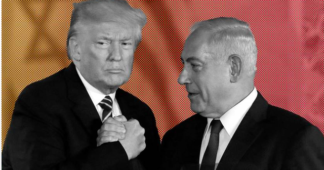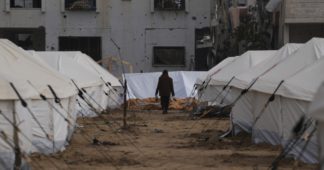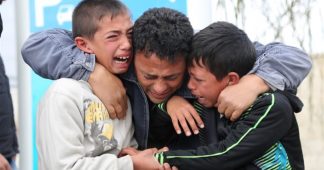By Barak Ravid
May 5, 2025
Israel has set President Trump’s visit to the Middle East next week as a deadline for a new hostage and ceasefire deal, with a massive ground operation to commence if no deal is reached, Israeli officials say.
Why it matters: Israel’s Security Cabinet approved a plan Sunday night to gradually reoccupy all of Gaza and hold it indefinitely if no deal is reached by May 15. Plans for the operation call for the Israel Defense Forces (IDF) to flatten any buildings that remain standing and displace virtually the entire population of 2 million people to a single “humanitarian area.”
- The alternative to remaining in the humanitarian zone is for Palestinians to leave the enclave “voluntarily” for other countries “in line with President Trump’s vision for Gaza,” an Israeli official said.
- Such departures could hardly be considered voluntary, and no country has agreed thus far to accept displaced Palestinians. Israeli officials claim there are ongoing negotiations with several countries on that front.
Between the lines: Many Israeli officials see this operation as a nuclear option and would much prefer a deal in the next two weeks.
- Trump is not currently playing an active role in efforts to reach a ceasefire and has effectively given Prime Minister Benjamin Netanyahu a green light to do as he sees fit, Israeli officials say.
The big picture: The return to full-fledged war would come after Israel already cut off all supplies of food, water and medicine for civilians in Gaza after the ceasefire broke down two months ago.
- Israel’s military operations in Gaza have killed 52,000 Palestinians, most of them civilians, according to the health ministry in Hamas-led Gaza.
- Netanyahu has rejected any proposal that ends the war entirely, pressing Hamas instead to sign a shorter-term agreement.
- Israeli officials hope the threat of a large-scale invasion will press Hamas to accept a deal on Israel’s terms.
Split screen: Trump will travel to the Middle East starting Monday for a three-day visit to Saudi Arabia, Qatar and the United Arab Emirates.
- Trump is not currently expected to visit Israel. U.S. and Israeli officials say the ongoing war in Gaza is the primary reason. “Nothing good can come out of a visit to Israel at the moment,” one U.S. official told Axios.
Between the lines: U.S. and Arab officials involved in the preparations for the trip said Gaza is not a top priority for Trump, and he’s expected to focus on bilateral issues and investments.
- “The optics around President Trump’s visit to the region in the context of the war in Gaza are very bad. He made a big splash pushing for a ceasefire before his inauguration and got it done, but three months later the situation in Gaza is worse,” an Arab official said.
State of play: Israeli and U.S. officials admit that the negotiations over the Gaza ceasefire and hostage deal are stuck.
- While Israel wants a partial deal that involves the release of eight to 10 hostages in return for a 45 to 60-day ceasefire. Hamas demands a comprehensive deal to end the war and release all 59 remaining hostages.
- All efforts to span that gap have failed. The White House focus has shifted to the Russia-Ukraine war and nuclear talks with Iran, with little to no bandwidth for Gaza, Israeli and U.S. officials say.
- The officials said the Trump administration isn’t pressing Israel at all and made clear to the Egyptian and Qatari mediators that a temporary deal along the lines White House envoy Steve Witkoff laid out two months ago, backed by Israel, is the only game in town.
Zoom in: The plan Israel approved Sunday, codenamed “Gideon’s Chariots,” is aimed at “completely defeating Hamas,” Israeli officials said.
- According to the plan, the IDF would invade Gaza with four or five armored and infantry divisions and gradually occupy and hold most of the strip.
- Israel’s ultranationalist finance minister Betzalel Smotrich said Monday that the occupation would be permanent and the IDF wouldn’t pull back even in return for the release of the hostages. An Israeli defense official said permanent occupation is only an “aspiration.”
The tactic will be massive destruction.
- As the IDF occupies parts of Gaza, it will flatten all buildings and work on destroying tunnel networks, as it did previously in Rafah and in the northern Gaza Strip.
- The IDF is planning to displace close to 2 million Palestinians to the Rafah area, where compounds for the delivery of humanitarian aid are being built.
- According to the plan, all Palestinians who enter the humanitarian area will be screened to make sure they’re not armed and not members of Hamas.
- The compounds are to be managed by a new international foundation and private U.S. companies, though it’s unclear how the plan will function after the UN and all aid organizations announced they won’t take part.
The latest: On Monday, Trump told reporters in the Oval Office that he would help get food to people in Gaza. “They are starving. Hamas is making it impossible because they are getting everything brought in. We are going to help the people of Gaza because they have been treated very badly by Hamas,” he said.
The Israeli Cabinet decision is highly controversial domestically, especially because it entails the mobilization of 70,000 reservists, most of whom have served for more than 300 days since the Oct. 7 attacks.
- The IDF is concerned that 30-50% of the reservists won’t show up, officials say.
- Most of the families of Israeli hostages vehemently oppose the operation, which they say will endanger their loved ones.
- Recent polls showed 60-70% of Israelis oppose a major operation to occupy Gaza and support a deal to end the war and free the hostages. The polls showed a majority of Israelis think Netanyahu is continuing the war for political reasons.
What’s next: “The preparations for the operation allow a window of opportunity until the end of President Trump’s trip to the region to reach a hostage and ceasefire deal. If no deal is reached, the operation will go forward,” an Israeli official said.
We remind our readers that publication of articles on our site does not mean that we agree with what is written. Our policy is to publish anything which we consider of interest, so as to assist our readers in forming their opinions. Sometimes we even publish articles with which we totally disagree, since we believe it is important for our readers to be informed on as wide a spectrum of views as possible.











